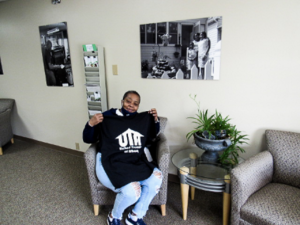After the storm, will the calm come?
“Salpicon of ideas”
by Pablo Álvarez
A helping hand in housing for tenants facing uncertainty in Albany, New York.
Lovett Branch took a deep breath.
The last message was intense, she needed to recover before returning the phone call. But the phone kept ringing non-stop. Although she didn’t know who was on the other end of the line, it was safe to assume that that person needed her help. She is not a psychic, nor does she have a cape on her back; but for many Albany renters she is the closest thing to a hero.
Branch’s job is to respond to messages left on the United Tenants of Albany (UTA) hotline, a nonprofit community organization that works to improve housing conditions, both in terms of repairs and issues with tenants’ rights.
housing conditions, both in terms of repairs and issues with tenants’ rights.
Before the pandemic, UTA offices received between 40 and 60 calls daily ranging from people concerned about abusive landlords, the return of security deposits, and/or many other housing-related concerns. But when the pandemic forced confinement in our homes, things got worse. The number of calls doubled, and Branch was now answering calls from her own home.
“It was all so crazy,” Branch said, referring to the early months of the pandemic. Then he added, “It’s all very crazy, and things are going to get worse when this is all over.”
After the end of the eviction moratorium in New York, housing courts will resume their activity, exposing thousands of tenants to losing their homes. In the New York City metropolitan area, 66% of Latino adults live in a household that has experienced a loss of income from work since mid-March. When mandatory closings occurred in the region, Latinos suffered the greatest impact (compared to 51% of white adults, 56% of blacks, and 58% of Asians).
Laura Felt is UTA’s executive director and says the eviction moratorium has been used across the country to mitigate and prevent the spread of the virus in homeless shelters. “It was not what we demanded and we believed it was necessary and humane. But it is still important to see that when we fight for something, we can achieve something”.
Branch, on the other hand, says that there are owners who do not want to leave their tenants on the street, but they are in the minority. Also true is that if they vacate their properties, they don’t know when they will be able to re-rent those newly vacant units. Therefore, many of them find themselves in this dilemma: “Do I evict the tenants who did not pay and receive no income while I wait to rent the unit again, or do I work with the existing tenants?” In many cases, the eviction moratorium is a remedy which, in the long run, can be worse than the problem it was meant to solve.
After the latest extension, the federal moratorium expires in August, which could force people who owe back rent to lose their homes. Although it is difficult to know how much is owed in arrears, since high-quality data is not available. It is estimated that the debt may exceed $52 billion and growing while the possibilities of paying that debt diminish more and more.
“I try to negotiate and be a mediator,” Branch says. She adds with a fated tone, “Sometimes all I can do is all I can do. It’s very frustrating because I like what I do.”
Lovett has an expressive way of talking. She uses pauses and tone changes that help her callers imagine her face and the gestures she makes when speaking. When she talks about the times tenants call her to give updates, or thank her for helping them, she sounds enthusiastic. One can tell she is smiling from ear to ear. Branch has a face that can immediately look familiar, with a combination of high cheekbones, an everlasting smile, and wise eyes.
When Branch talks about the tenants’ future, her voice slows down and makes long pauses as she searches for the words. Branch says that what worries her the most is not that people could end up in a homeless shelter. The bigger problem, according to Branch, is that there are not enough shelters in Albany for all those people.
“Now they better start looking for shelters to put all these people. Here in Albany, the vast majority of shelters are aimed for single men, when many of the people at risk of losing their homes are women with children”. Branch says that’s what keeps her up at night.
She is afraid of leaving her office and finding families with their children sleeping on the street. Albany has just three women’s shelters, which is a bleak picture.
 According to Julia Ofman, who works for the Family Homelessness Coalition, being aware of the seriousness of the problem is vital so that public opinion can directly influence the amount of money available to help this cause. Many are unaware that nearly 70% of New York City homeless shelter users are families with children, and the vast majority of these families are headed by single mothers, according to the Department of Homeless Services.
According to Julia Ofman, who works for the Family Homelessness Coalition, being aware of the seriousness of the problem is vital so that public opinion can directly influence the amount of money available to help this cause. Many are unaware that nearly 70% of New York City homeless shelter users are families with children, and the vast majority of these families are headed by single mothers, according to the Department of Homeless Services.
A 2019 study found that 88% of people believe that health problems lead to helplessness. Eviction can create other health problems. The Department of Education reported that 14,549 pre-kindergarten and kindergarten students were homeless in New York City at some point in the past school year.
This is worrying information. The American Psychological Association points out that homelessness is traumatic for everyone, but especially for children as “they face serious threats to their ability to succeed and their future well-being. Of particular concern are health problems, hunger, poor nutrition, developmental delays, anxiety, depression, behavior problems and poor educational performance,” creating a vicious cycle that is transmitted to future generations.
The only encouraging thing about this scenario seems to be that there are people like Lovett, who will be there, on the other side of the phone line, waiting with endless patience, always ready to spread smiles and transform into what people need.
“When they call me and ask me: ‘Ms. Lovett, how do I do this, or how do I do that?’ Sometimes I find myself being more than just the hotline operator. I am an advocate for tenants, a social worker… and well… a helping hand.”
The photo shows Lovett in the waiting room of the Albany Tenants United offices (UTA)
My name is Pablo Álvarez and I have the privilege of joining the family of writers for the CNY Latino newspaper in January 2021. My column will try to reflect the same degree of diversity as my academic formation, which is why I decided to call it “Salpicon of ideas”. I will address current issues with a varied approach, that I hope is also of interest to our community. Although it sounds a bit strange, I’m proposing a more or less open relationship. Let’s just say that I don’t promise to be exclusive in my content, since I also write fiction. However, I faithfully commit to you that I will give my best in these monthly meetings. I hope you do the same. Read as much as you can, since knowledge does not take up space, but try to return every month to this corner of the CNY Latino newspaper to continue cultivating this friendship.
try to reflect the same degree of diversity as my academic formation, which is why I decided to call it “Salpicon of ideas”. I will address current issues with a varied approach, that I hope is also of interest to our community. Although it sounds a bit strange, I’m proposing a more or less open relationship. Let’s just say that I don’t promise to be exclusive in my content, since I also write fiction. However, I faithfully commit to you that I will give my best in these monthly meetings. I hope you do the same. Read as much as you can, since knowledge does not take up space, but try to return every month to this corner of the CNY Latino newspaper to continue cultivating this friendship.


